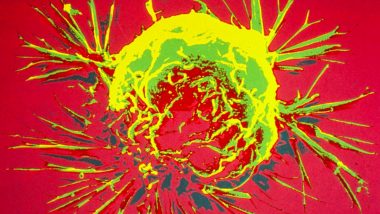Washington D.C., November 23: Researchers have developed a new cancer-detecting tool, which uses tiny circuits made up of DNA to identify cancer cells by the molecular signatures on their surface. Duke University researchers fashioned the simple circuits from interacting strands of synthetic DNA that are tens of thousands of times finer than a human hair. Causes of Cancer: From Red Meat to Potato Chips, 8 Everyday Things You Didn't Know Could Lead To Uncontrolled Growth of Abnormal Cells.
Unlike the circuits in a computer, these circuits work by attaching to the outside of a cell and analysing it for proteins found in greater numbers on some cell types than others. If a circuit finds its targets, it labels the cell with a tiny light-up tag. Because the devices distinguish cell types with higher specificity than previous methods, the researchers hope their work might improve diagnosis, and give cancer therapies better aim.
A team led by Duke computer scientist John Reif and his former PhD student Tianqi Song described their approach in a recent issue of the Journal of the American Chemical Society. Similar techniques have been used previously to detect cancer, but they're more prone to false alarms, misidentifications that occur when mixtures of cells sport one or more of the proteins a DNA circuit is designed to screen for, but no single cell type has them all.
For every cancer cell that is correctly detected using current methods, some fraction of healthy cells also get mislabelled as possibly cancerous when they're not.Each type of cancer cell has a characteristic set of cell membrane proteins on its cell surface. To cut down on cases of mistaken identity, the Duke team designed a DNA circuit that must latch onto that specific combination of proteins on the same cell to work.As a result, they're much less likely to flag the wrong cells, Reif said.
The technology could be used as a screening tool to help rule out cancer, which could mean fewer unnecessary follow-ups, or to develop more targeted cancer treatments with fewer side effects.To look for cancer, the circuit components are mixed with a person's cells in the lab. If any cells are studded with the right combination of proteins, the complete circuit will attach. Adding a strand of 'initiator' DNA, then causes one of the hairpins to open, which in turn triggers another in a chain reaction until the last hairpin in the circuit is opened and the cell lights up. 10 Facts About Cancer You Need to Know by World Health Organization (WHO).
Test runs of the device in test tubes in Reif's lab showed it can be used to detect leukaemia cells and to distinguish them from other types of cancer within a matter of hours, just by the strength of their glow. The devices can easily be reconfigured to detect different cell surface proteins by replacing the tether strands, the researchers say. In the future, Reif plans to make the DNA circuits to release a small molecule that alerts the body's immune system to attack the cancer cell.
The technology isn't ready for prime time yet. The researchers say their DNA circuits require testing in more realistic conditions to make sure they still flag the right cells.But it's a promising step toward ensuring that cancer screens and therapies zero in on the right culprits.













 Quickly
Quickly












